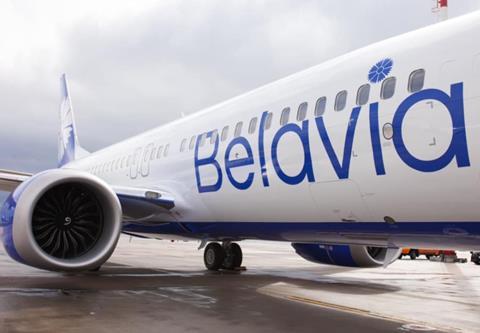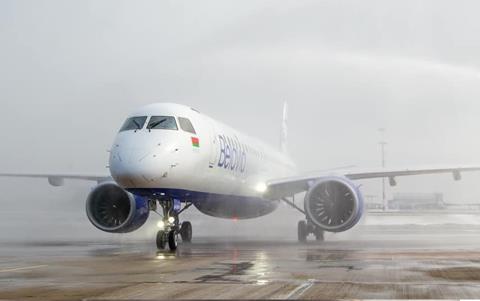Just a couple of days before the Ryanair diversion incident pitched Belrusian flag-carrier Belavia into a new crisis, it started putting its first Boeing 737 Max into operation as part of its efforts to clamber out of the current one.
Belavia agreed in 2018 to lease a batch of Max 8s and received its initial aircraft in April – two years later than scheduled, following the type’s prolonged grounding. It had started carrying out its own test flights in mid-May, after a further hold-up as Boeing conducted additional inspections of the aircraft’s standby power control systems.
The carrier had opted to put the jet into service on the Warsaw and Kiev routes, popular destinations on its network, but within a week the two capitals were among an increasing number of cities closed to Belavia flights in response to the Belarusian government’s diversion of a Ryanair flight – apparently for political ends – to Minsk on 23 May. It has been forced to find alternative sectors, from a thinning number of options, on which to operate the Max.
Belavia’s situation will be something of a hazing for its new chief, Igor Cherginets, who only took over from long-term head Anatoly Gusarov three months ago, and had been overseeing the introduction of the 737 Max to service. The carrier had also brought in a third Embraer 195-E2 in early May after taking its second in March.

“Owing to circumstances beyond the control of the airline, Belavia is forced to cancel dozens of flights during the peak season,” the carrier says. “The situation is complicated by the fact that the carrier has recently begun to recover from massive flight cancellations due to the pandemic.”
Belavia’s full-year financial results for 2020 show the airline suffered a net loss of Br92.1 million ($36.4 million) – a contrast to the previous Br68.2 million profit – as passenger traffic halved and revenues fell by more than 40% to Br522 million.
The airline suspended scheduled flights to multiple countries over the first half of 2020, and reduced frequency on other scheduled routes as transit flows slowed, while charter and humanitarian operations were also badly affected.
Belavia says it “managed to adapt quickly” and find new markets, including ships’ crews and seasonal workers, to maintain passenger transit flow through Minsk. The carrier says it was praised by foreign governments – including those of Sweden, the USA, UK, Israel and Russia – for providing flights at a time when transport options were limited.
It partially restored services to several cities on its network in the second half, and even opened new routes to cities including Vienna and Tashkent, although the resurgence of the pandemic slowed the airline’s recovery.
Belavia generated Br360 million in scheduled flight revenues last year, down 45%, and Br131 million in charter revenues, down 29%.
It decommissioned seven older aircraft last year and introduced four newer models, including two Boeing 737-800s, an Embraer 195-E2 and an Embraer 175. It ended 2020 with a fleet of 30 aircraft, among them nine 737-800s and six older 737s, 13 Embraer regional jets and two Bombardier CRJs.
“Despite the global crisis caused by the pandemic, the airline continued renewal of the aircraft fleet under previously-concluded leasing agreement,” said Belavia in its 2020 financial statement.
The modernisation with “new expensive aircraft”, combined with other circumstances, put pressure on the airline’s liquidity ratios, it added, but said the aircraft acquisitions and operating leases were a “major investment” in the airline’s future development, and its financial position would “gradually improve”.

Cherginets, speaking as Belavia prepared to start 737 Max flights in mid-May, confidently said: “Undoubtedly the modernisation of the fleet will facilitate expansion of the route network, opening of new [destinations], and an increase in passenger traffic.”
But the repercussions from the Ryanair incident have thrown Belavia’s recovery progress into jeopardy. Several European Union countries have barred Belavia flights and it has also had to cancel services to the Russian exclave of Kaliningrad, just 250nm from Minsk but practically inaccessible with the airspace restrictions in place.
Despite the problems, it is proceeding with the opening of a new Russian route to Ufa on 31 May.
Belavia employed nearly 2,100 personnel at the beginning of 2021, and claims it did not shed any staff as a result of the pandemic.
But it admits that, with the enforced flight cancellations and re-routing of other services, cutting costs and optimising personnel numbers are “unpleasant but logical steps” – although it insists that “mass reductions” are not being considered.
Belavia has yet to put a figure on the damage being inflicted, citing the “rapidly-developing situation” and the fact that its priority is to address the needs of its customers.
The state-owned airline is not the only Belarusian aviation entity disrupted by the stand-off.
With the recommendation from the European Union Aviation Safety Agency that flights avoid Belarusian airspace, the air navigation service Belaeronavigatsia is set to lose the income stream from air traffic control charges.
Eurocontrol lists the unit charge for Belarus route services in 2021 as €43.28 ($52.75), with the total charge for a flight dependent on the distance flown and the aircraft’s maximum take-off weight.
The Ryanair incident was badly-timed for Belaeronavigatsia, which had formally opened its new Minsk air traffic centre just a week beforehand on 15 May.
Belaeronavigatsia says the new centre, with its modernised equipment, is the most important project to be pursued by the organisation over the past five years, able to treble the capacity of Belarus’s airspace and “build up the country’s transit potential” – although between the pandemic and the isolation of the Minsk flight information region, lack of capacity is unlikely to be a troublesome issue in the short term.


























